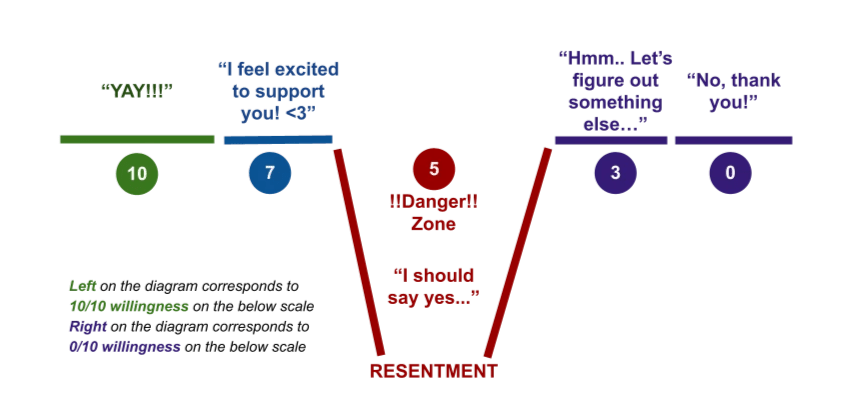
- NVC Workshops
- Community
- …
- NVC Workshops
- Community
- NVC Workshops
- Community
- …
- NVC Workshops
- Community
Living in Willingness - Dev Copy
Sometimes we say yes when we do not know what else to say.
What if you could manage to only do and experienced things that you are really enthusiastic about?
The Invitation
Instead of saying "yes" right away, when we receive a request (an offer, a demand, coercion, a bid, an incentive, or really anything), we can try asking ourselves:
- How do I feel about this? Why might I say yes to this?
- What would this give me that I value (if anything)?
- Am I connected to the embodied needs that this serves for me?
- What impact do I expect? What possibilities am I choosing to be available for?
Below is a chart that can help us think of how offers might land for us. You can find a printable reference here.The Willingness Scale
Why am I saying yes to this? What would this give me that I value?
(Will it give me anything I value?) How do I feel about this?
- Embed an AppOr write your own HTML code! (HTML is Pro only)
Journal Practice
Set aside 30 minutes to consider this scale and the implications on how you’ve been living.
- When was the last time you did something because you were truly & deeply excited to do it? What did that feel like in your body?
- When was the last time you did something because you knew that if you didn’t, something bad would happen? What did that feel like in your body?
- What commitments do you have that you really don’t want to keep? What needs are those commitments serving? This might include a need for safety or financial security. Those are very real needs. Explore the needs wheel or needs list for other examples. When you consider the needs, do you notice a shift in your willingness? If you still don’t want to keep them, is there some other way to meet the needs that were being served?
- When do you do something for someone else from a deep & full sense of being willing?
Experiential Practice
Here are a few invitations to try over the next two weeks. I recommend only trying one of them at a time.
Pausing to Check Your Current Willingness While Acting
- Pick a notebook or a journaling app to use & title it “Acting with Willingness”
- Set 3 alarms on your phone at different times of the day, for example: 1pm; 5pm; 9pm
- When the alarm goes off, pause what you are doing
- In your journal spot, write down the time & date, what you are doing, and what stage of willingness you are doing this with
- After the two weeks are over, review & see if there are any important patterns. Try not to adjust your behaviors or change anything until the two weeks are over
Alternate approach (skip steps 4&5 above and try this instead):
4. Take a deep breath. Consider what you were just doing. What level of willingness do you have to do this activity?
5. If the answer is not a 1 or a 2, set a timer on your phone for 2 minutes. Brainstorm how you can change the activity so that you are doing it with more willingness. Rank your willingness to try these new ideas. If you have a willingness for at least one option of 1, 2, or 3, spend 5 minutes doing the version you have the highest willingness for.
6. If none of the ideas you write down seem appealing (at a level 10-7 of willingness), then ask yourself: what needs is this action meeting for me? This might be a need for safety or financial security. Those are very real needs. Explore the needs list for other examples.Pausing to Fully Receive a Request
- Count the number of times you receive a request in a day. Keep note of the number of requests you receive each day
- When you notice someone making a request, take a deep breath.
- See if you can notice how you feel in your body as you hear or read the request
- How do you feel about this?
If you found this helpful or have suggestions on how to make this better, I’d love to know!
I’d feel especially honored if you are willing to share any notes from trying the practices.
© 2023
